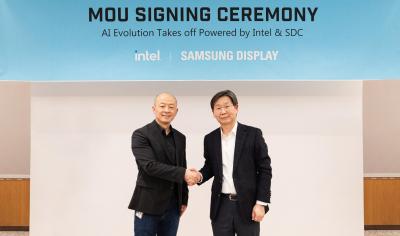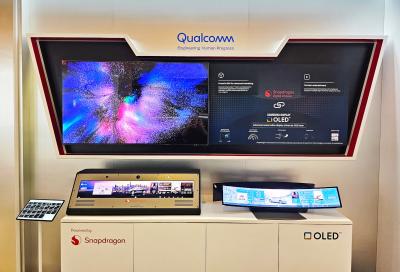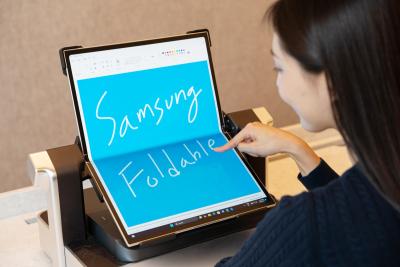 Samsung Display Corporation (SDC), one of the world's leading display makers, was spun off from Samsung Electronics in 2012. The company produces a wide range of displays, including LCDs, OLEDs, MicroLEDs and more.
Samsung Display Corporation (SDC), one of the world's leading display makers, was spun off from Samsung Electronics in 2012. The company produces a wide range of displays, including LCDs, OLEDs, MicroLEDs and more.
Samsung Display is the world's leading AMOLED producer by volume, and is also the world's only QD-OLED panel makers. SDC is producing around 500 million AMOLED panels per year (both flexible and rigid panels) used in smartphones, wearables, tablets, laptops and more. The company's QD-OLED panels are used in monitors and TVs.

In addition to its current AMOLED and QD-OLED displays, SDC is developing next-generation OLED technologies, including rollable OLEDs, transparent OLEDs, stretchable displays, OLED microdisplays, and more.
1 Samsung-Ro
Giheung-Gu
Yongin
South Korea
Samsung Display and Intel to co-develop OLED solutions for AI PCs
Samsung Display announced that it has signed a Memorandum of Understanding (MoU) with Intel to co-develop (and co-market) display solutions (based on Samsung's OLED and QD-OLED panels) optimized for Intel’s processor chips and explore opportunities in high-performance IT devices and artificial intelligence (AI) PCs.
The companies intend to work together at global exhibitions to showcase their latest innovations. Intel and Samsung also plan to apply Intel’s system-on-a-chip (SoC) technology to Samsung Display’s IT OLED panels to provide component solutions optimized for AI PCs, including high picture quality and low power consumption.
Hyundai Mobis aims to commercially launch a 18-inch rollable automotive display by 2028
According to reports from Korea, Hyundai Mobis has plans to launch a 18-inch rollable automotive display, ans has seemingly already signed up both General Motors, Hyundai Motors and Kia to adopt this display into four models, that will launch in 2028.
Hyundai Mobis hasn't yet selected the supplier of its rollable display, and it is talking to both Samsung Display and LG display. Both companies haven't yet commercialized automotive-grade rollable displays, and the development contract will have to be signed within a few months if the companies hope to have a commercial launch in 2028.
Reports suggest quality issues at BOE may shift iPhone OLED orders to Samsung Display and LG Display
Sources in Korea suggest that BOE struggles with supplying AMOLED panels to Apple's iPhone, and Apple may switch some of its orders to LG Display and Samsung Display.
BOE is supplying LTPS AMOLED displays to Apple's iPhone 14, 15 and 16 devices, but the company faces quality issues and Apple has rejected many of its displays. It is estimated that it will take at least 6 weeks for BOE to fix the OLED quality problems, and meanwhile since the beginning of 2024 it managed to ship only about 7-8 million panels to Apple - from orders of around 40 million units.
Samsung Display to supply automotive AMOLEDs for Qualcomm's demonstration cockpits
Samsung Display announced that it has signed a Memorandum of Understanding (MoU) with Qualcomm Technologies, for a potential supply of AMOLED display for Qualcomm Technologies’ Snapdragon Cockpit Experience Development Platform (CEDP) to provide next generation in-cabin experiences.
Qualcomm's Snapdragon CEDP is designed to deliver advanced functionality to help automakers build highly immersive, intuitive and sophisticated in-vehicle experiences. SDC will provide a 34-inch 6K (6,008 x 934) wide OLED display for the CEDP demo kit.
Samsung Display to start producing rollable OLED laptop displays in April 2025, Lenovo is its first customer
Samsung Display unveiled a 18.1" rollable OLED laptop display at CES 2025, one that can roll down to 13.1" when closed. The company today announced that it aims to begin mass producing rollable OLED displays in April 2025. This will mark the first ever mass produced rollable display (apart for the limited volume production of LG's 65" rollable TV screens, that are discontinued).
During CES, Lenovo demonstrated the first laptop to use such a rollable OLED, the ThinkBook Plus G6 Rollable laptop. Lenovo plans to launch it globally in June 2025. The ThinkBook Plus G6 Rollable will have a 14" 5:4 display when rolled in, and a 16.7" 8:9 display when opened. That's an increase of almost 50% in screen size. The price of Lenovo rollable laptop will start at $3,499 - this is a ultra premium device.
Samsung Electronics announced its 2025 OLED TV range
Samsung Electronics announced its 2025 OLED TV range, with three different series. The TVs use a combination of SDC's QD-OLED panels (latest generation that reaches 4,000 nits) and LGD's OLEDs.
The top of the range is the S95F, Samsung's flagship 2025 TV, that will be available in 55", 65", 77" and 83" sizes. The S95F offers 4K 165hzQD-OLED panels (except the 83-inch model which uses LG's WOLEDs, apparently). The S95F TVs use Samsung's new NQ4 AI Gen3 video processor.
Samsung Display shows new OLED technologies at CES 2025
Samsung Display is set to show new OLED technologies at CES 2025, including new foldable display, rollable ones, automotive displays, next-gen QD-OLED panels and more.
So first up, Samsung will be showing a 18.1 foldable OLED display (which it says is the world's largest). This panel is suitable for IT devices - to enable devices that combine tablet, laptop and monitor devices into one. When folded, this display is 13.1" in size.
Samsung Display signs a strategic partnership with Dolby to improve its automotive OLED displays
Samsung Display announced today a strategic partnership with Dolby Laboratories, to offer SDC's automotive displays which are pre-tuned to deliver Dolby Vision to automotive makers.
Samsungs says that by implementing a new streamlined evaluation and implementation process it will be able to offer best-in-class imaging experiences for automotive displays.
UBI Research: the OLED emitter market reaches a new high in Q3 2024
UBI Research estimates that the volume of OLED emitting materials purchased in Q3 2024 reached 32.7 tons, which is the highest ever, with the previous record in 2021. UBI expects 2024 as a whole to be the record year in OLED emitter material shipments.
In terms of customers, SDC holds the largest share with 41.4% of the total market, followed by LGD (20.5%), BOE (11.6%) and Visionox (8.3%). In terms of architecture, 83.7% of all emitter materials went into RGB OLEDs, 11.3% into WOLED (LG's WRGB) panels and 2.8% into QD-OLED panels.
Samsung may convert its 5.5-Gen A2 OLED fab to a microdisplay production line
A few weeks ago it was reported that Apple is aiming to develop a lower-cost VR headset, and will want to use cheaper OLED microdisplays to replace the high-end Sony OLED microdisplays used in the Vision Pro. It was reported that both Samsung and JDI are in talks with Apple, that aims to achieve a pixel density of 1500 PPI (the Sony microdisplays sport 3,400 PPI). Samsung meanwhile develops its own headsets, and is also working on solutions for other leading companies, such as Microsoft.
 A 1.3" 12000 nits OLED microdisplay (Samsung Display)
A 1.3" 12000 nits OLED microdisplay (Samsung Display)
While Samsung is working on an OLED on silicon microdisplay factory, the company is also looking to start producing high resolution AMOLED displays on glass. According to a new report, Samsung is now looking to build a new AMOLED on glass microdisplay pilot production line in Asan, and later on the company is considering to converts its 5.5-Gen (1300x1500 mm) A2 OLED production line to produce OLED microdisplays. Samsung will have to modify its production process and install new equipment to support the high resolution. The company reportedly aims to order the required equipment in 2025.
Pagination
- Page 1
- Next page








